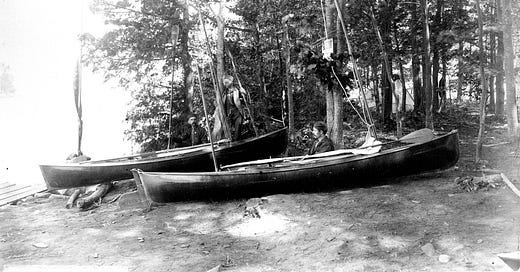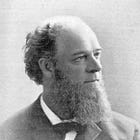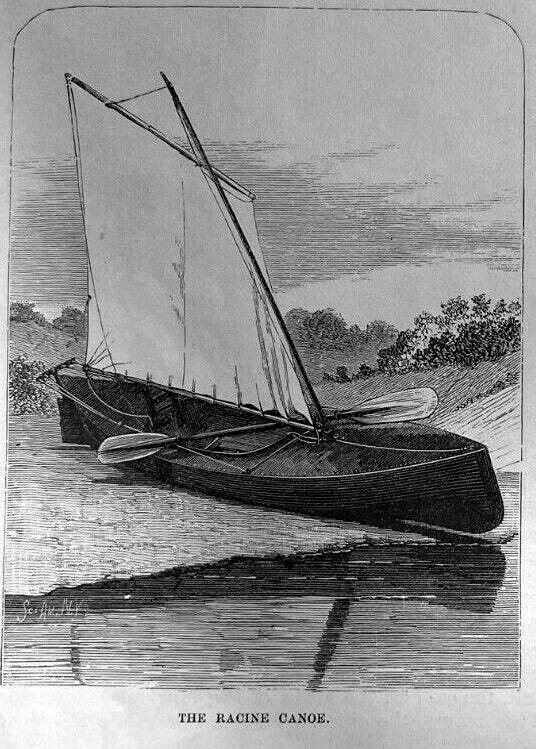The Epic Canoe Journey of George W. Gardner: PART 2
The conveyance, the cargo and the Commodore

Before you start reading Part 2, make sure you’re all caught up!
Release Date: April 8, 2025
The birth of the cruising canoe
George Gardner and William Eckman benefitted from a boom in recreational canoeing in America which had its beginnings at the end of the Civil War, and thanks, in much part to one man, John “Rob Roy” MacGregor. The son of a Scottish soldier, John’s experience on the water had taken an ugly turn early: at just four weeks old, he was a passenger aboard the British East India Company’s merchant ship, Kent, when, on March 1, 1825, the boat caught fire. Of the 641 persons onboard, 81 perished.
Despite this early trauma, John went on to become an avid traveler and, after a trip to America and Canada at age 33, an enthusiastic canoeist. In 1865, he contracted with London-based skiff builders Searles of Lambeth to create a new kind of boat, a recreational cruising canoe.
John’s canoe, dubbed the Rob Roy, was 15ft long by 2ft 6in wide and weighted 77 lbs. It featured cedar planking on oak frames and a large, open cockpit in which the canoeist would sit, propelling the canoe with a double-bladed paddle or, if they preferred, by using a small lugsail.1
To christen his new craft, John took it on a thousand-mile test paddle. In the introduction to the book he wrote about his adventure, “A Thousand Miles in the Rob Roy Canoe: On Rivers and Lakes of Europe”, John detailed his journey thusly:
The waters navigated were as follows:
The Rivers Thames, Sambre, Meuse, Rhine, Main, Danube, Reuss, Aar, Ill, Moselle, Meurthe, Marne, and Seine.
The Lakes Titisee, Constance, Unter See, Zurich, Zug, and Lucerne, together with six canals in Belgium and France, and two expeditions in the open sea of the British Channel. 2
The book was popular in Europe, but a huge hit in the United States. Within four years, canoe clubs were popping up across America, beginning in New York in 1870.
In late 1880, George and William were in New York and a common friend took the two to see one of the new breed of canoes. According to newspaper reports, it was love at first sight.
Mr. Gardner at once purchased a Shadow canoe, and took it to Ballast Island. Mr. Eckman procured a Racine, and in a few weeks the [Cleveland Canoe Club] was formed, 3 with George installed as Commodore and William as Secretary. 4
The City of Cleveland and The Cuyahoga
Although the canoes George and William purchased in New York – The City of Cleveland and The Cuyahoga – were direct descendants of John MacGregor’s Rob Roy, a number of things had changed in the intervening decades, as detailed in an article about the cruising crafts paddled and sailed by members of the Cleveland Canoe Club:
In the canoes of the present the material differs little. The keelsons are of oak, the stem and stern posts of oak or hackmatack, the siding of white cedar, the top streak of Spanish cedar, the timbers of white cedar, the deck and hatches of mahogany, the ribs of red elm, the coaming, battens, and gunwales of black walnut, and all the fastenings of copper and brass. All canoes are in finished in oil and varnished, and the decks polished.
In weight of material and method of construction, the canoe is much like an open boat. When the shell has been put up, it is tiled inside, covered with shellac, and the ribs put in. Then come the deck timbers, about three-fourths by seven-eighths of an inch in size, the bulkhead, the coaming, the mast steps, and the air tanks. The inside is treated again to varnish and shellac, after which the deck and hatches are put on. The size of the air tanks varies, the smallest pair being capable of supporting seventy pounds, dead weight.
Nearly every canoe has a dry storage compartment. All the fittings are neat and bright and glisten like silver, Double paddles are used, joined in the middle, and several combinations of sails and riggings can be procured. Foot pedals are arranged for steering purposes, and a brass centerboard, called a radix, folds up like a fan in a hollow in the keelson.5
Please hit the ❤️ button at the bottom of the page to help this story reach more readers. And if you’re not already a subscriber, I’d love to have you join me. Thanks!
In terms of size, The City of Cleveland and The Cuyahoga were somewhat smaller and wider than their forebearers, coming in at 14 ft long and 30 inches wide. But they were also capable of carrying 100 pounds of gear, and George and William used – and needed – every ounce of that capacity during their three-month adventure on the Ohio and Mississippi rivers.
No article in the lot was a superfluity, nor do I now recall an occasion when anything was requisite which was not at hand. The blankets were folded with great care to fit the floor of the cockpit, and laced up in the rubber blankets to prevent wetting, and thus furnish a soft seat when paddling, and an easy lounge when sailing.
The masts and sails were folded around the long boom and lashed on deck; the rubber garments, rough weather hatchet and caps, pipe, matches, tobacco pouches, hardtack, charts, compass, and field glass were stowed within easy reach, the balance of the outfit being arranged in the watertight apartments. 6 ~ George Gardner
So what did they actually carry? According to George’s log, the combined inventory of the two canoes included:
Camping equipment – one canvas duck A tent, three feet high at the ridge and covering 6x8 feet when set up, with a complement of pins, canoe masts being used for tent poles. This tend can accommodate three. Eight single wool blankets, three rubber blankets, two padded comfortables, one life preserver used for a pillow, one air cushion, one rubber bag, one wash basin, paper, four towels, one box toilet soap, combs and brushes, headquarters flag.
Quartermaster’s stores – three lanterns, one large bottle of matches, selected wove cordage, one hatchet, one brad awl, one large clasp knife, one pike pole, one set lifting belts, one wrench, one compass, one thermometer, two sponges, two sets lateen sails, two sets colors, two canvas hatches, two trolling lines, four briarwood pipes, one set Mississippi river charts, two bamboo cash cases, and two ditto chart cases presented by Captain Ellert of Cincinnati, four pairs paddles.
The cuisine – one two-gallon copper kettles with a bail and cover enclosing the following made to fit snugly therein; one deep stew pan, one iron skillet with folding handles, four quarter round cases for sugar, coffee, tea and salt made to fit into the pan and one-half pint cup. This very compact apparatus was presented by the Cincinnati Club. Four tin plates, two sets knives and forks, one large table knife, two tablespoons, six tin cups, one pocket spirit stove used for cooking on board and in the tent, when stress of weather or other cause prevented the building of a campfire.
Subsistence and other stores – six and three-fourths pounds bacon, five pounds flour, wight pounds hard tack, one-half peck potatoes, two pounds granulated sugar, two pounds ground Java coffee, one pound black tea, three pint cans backed beans, two pint cans prepared soup, one bottle pickles, one can condensed milk, two pounds butter, two pounds oatmeal, one-half dozen lemons, one box (two pounds salt, four ounces black pepper, one box 500 matches, one quarter alcohol, one-half gallon lamp oil, four pounds smoking tobacco.
Miscellaneous – one canvas portfolio containing writing paper, envelopes, postage stamps, book of manifold paper, one memorandum book, one sketch book, and the log; the portfolio was carefully wrapped in a waterproof cloth held with rubber bands; one pack of playing cards, two distance tables, one river guide, one pair field glasses. 7

Ducks make the man
The final bit of kit carried in the canoes was clothing, including what George called his “butternut duck” a practical but unpredictable outfit of durable cotton canvas fabric with a light brown color which seems to have added, not only protection from the elements, but also a bit of humor to the journey:
It was simple – a baggy roundabout buttoned to a pair of bagger pantaloons, both made of butternut duck – simple in material and construction, but, my sympathetic friends, those roundabouts and pants developed such improbable possibilities, suggested such thoughts, around such fears and hopes, and created such divergent and recordable modes aroused such fears and hopes, and crated such divergent and reconcilable moods of hilarity and despondency as to keep our minds in a constantly unsettled state. We could never be certain as to what new and unsuspecting shape those garments might take upon themselves. The wrinkles and kinks were a sight to behold in their calmest moments, but when they took a notion, it was a picnic.
McGinty was nowhere in his best suit. There were hills and valleys, yes mountain tops and canyons of butternut duck, not always in the same place, but in any place, and in the most unlikely places.
Clothes may not make the man, says the log, but a butternut suit of uncertain fit will obliterate every vestige of respectability possessed by the finest grained specimen of man that ever wheeled a paddle. Even the skipper (George), otherwise a man of most excellent parts and dignified bearing, became an ordinary guy, while the scribe’s (William) appearance was a standing invitation to every small boy who caught sight of him to open up his battery of slang –“oh, look at um,” “What is it?” “Did it blow in?” and “Ki-yi, fellers, it’s alive!”
We attribute our immunity from molestation by river thugs and thieves to our dress –however low down he might be, no thief would ever tackle a man in butternut duck in hope of realizing on the venture. It is to be said, however, that for the purpose, the suits were perfect. ~ George Gardner 8
With the the canoes packed to the gills, and everything they needed for their journey at hand, Georg and William were one step closer to their paddle down the Mississippi. But they were nowhere near ready — that would take time, patience and a totally new way of life on the water.
Copyright 2025 Lori Olson White
Have you read the incredible true story of Aimee Henry and Mary Martha Parker? Call Me a Bastard is my longest serialized story to-date, and the one that started it all here on the Lost & Found Story Box. Check out the story from the beginning.
Please hit the ❤️ button at the bottom of the page to help this story reach more readers. And if you’re not already a subscriber, I’d love to have you join me. Thanks!
The Lost & Found Story Box is reader-supported. When you buy through links on our site, we may earn an affiliate commission.
End Notes
1 Stephanie Meyric-Hughes, “John Rob Roy MacGregor: the man who invented the sport of kayaking”, Claslsic Boat, November 25, 2015, .
2 John MacGregor, “A Thousand Miles in the Rob Roy Canoe: On Rivers and Lakes of Europe”, London: Sampson Low, Son, and Martson; Milton House, Ludgate-Hill. 1866.
3 “Little Skimmers: The Cleveland Canoe Club Race for a Silver Challenge Cup in the Barbor”, The Cleveland Leader, Cleveland, OH, June 13, 1886, P. 8.
4 “The Cleveland. Canoe Club”, The Evening Post, Cleveland, OH, November 10, 1880, P.1.
5 “Little Skimmers: The Cleveland Canoe Club Race for a Silver Challenge Cup in the Barbor”, The Cleveland Leader, Cleveland, OH, June 13, 1886, P. 8.
6-9 “The Mayor in a Canoe: His Adventures. Between Porkopolis and the Crescent City in Midwinter”, The Cleveland Leader, Cleveland, OH, January 26, 1890, P. 10.
More info on Sailing canoes
O. S. Tyson, “Sailing Canoes: A Brief History together with an outline of Types, Classes, Designs and Classifications”, American Canoe Association, 1935.









Tremendous level of detail you unearthed. I've seen photos of such touring canoes, but didn't know their origin. Fascinating.
I love the canoe costume!